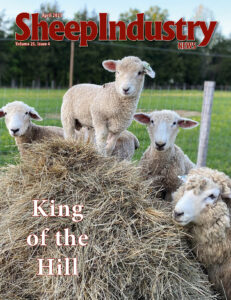MIKKEL PATES
Agweek
The Pipestone Lamb and Wool Program is nearly 50 years old and using new tools to shepherd producers into an increasingly profitable enterprise.
Instructors are based at Minnesota West Community and Technical College at Pipestone, Minn., but spend much of their time on the road to the 120 farms they serve, primarily in Minnesota, South Dakota, Nebraska and Iowa.
The staff is led by veteran instructor Philip Berg, who grew up on his family’s Pipestone area sheep farm. He’s been an instructor with the Pipestone program since 2005.
LIKE ‘CROP CONSULTING’
The Pipestone program is the only one Berg knows of in the U.S. with all of its parts — research-backed education, consultation, networking and risk management through marketing.
“I consider part of our program is very similar to crop consulting, where they’re coming out and viewing their crop,” Berg said. “We’re going out and viewing their facilities, viewing their ewes, looking at their body condition, looking at the lambs, at how they’re growing.
“Recently we’ve had a lot of excitement in the sheep industry because of some of the economics that we’ve seen,” Berg said.
Ann Kolthoff of Brookings, S.D., joined as a new instructor in July 2020. She says the best thing about the program is helping producers.
“Right now we’re starting our lambing season,” Kolthoff said. “What they’re worried about at this point in time is items that are going to affect their lambing season, and keep their lambs alive.”
YOUNG & GROWING
On a February farm visit, Kolthoff visited the snug lambing barn that Brian Fruechte and his wife, Kim, built in the past year in Verdi, Minn. As they strolled through the Fruechte’s new facilities, the topics ranged from nutrition to equipment.
The Fruechtes, both 37, said they’re making sheep a focal point of their diversified farming family life. After graduating from Pipestone High School, Brian and Kim went on to SDSU. They graduated in 2005 — Brian in ag economics/ag business, and Kim in consumer affairs/human resources. They married, worked briefly in Sioux Falls, S.D., and returned to farm when his grandfather — David — moved to town. The young couple raise corn and soybeans, sharing equipment with his father, Michael, who lives nearby. Brian also has started a crop insurance agency and a seed dealership.
Brian said raising sheep is part of his heritage. Michael once had about 600 ewes when his three sons were in high school. “As we slowly left the home he slowly replaced them with cattle,” Brian said.
In 2017, Brian and Kim bought 150 ewes.
Brian and Kim built two 30-by-85 foot hoop barns, but after the tough winter in 2019, they invested in an insulated, 30-by-36 foot pole shed lambing barn, situated between the hoop barns. This allows January lambing, instead of delaying until April.
The best part is that the Fruechte’s four children, ages 5 to 12, all can help. The kids can care for lambs and ewes, putting them into a “jug” — a small pen that confines the ewe with a new lamb – usually for three to five days. The kids have a handful of 4-H ewes and work with chores such as bedding, feeding and vaccinating.
Some younger producers see sheep as a “stepping stone” in their farming enterprise, Berg said.
“On average, probably 25 percent to 50 percent of their income comes from sheep,” he said.
Sheep offer profit opportunities in most years, he said. One thing that’s universal is that management plays a big role in profitability.
“If we’re doing a very good job managing our ewes, getting a lot of lambs born, keeping those lambs to market, it can be very profitable,” Berg acknowledged.
CHANGING TOOLS
Participants in the program pay for four to 10 college credits a year, which figures at $600 and up. They can earn a diploma from Minnesota West Community and Technical College.
The farms in the program average 400 to 500 ewes and range from 50 to 1,200 ewes.
Cost is based in part on the distance from Pipestone, but also on the flock size. The small flock rate is for 100 ewes or less, one visit per year in February to March. The intermediate level is for 100 to 200 ewes, with the February-March visit and a mid- to late-summer consultation. Farms of 200 ewes and above are full members, usually with three or four visits. Still another 15 are members more than 200 miles away and belong under the Sheep Central Consulting program, allowing two virtual visits per year.
The program officially started in 1972, then a joint effort of the National Sheep Industry Development Board, the technical college and the Minnesota Department of Education.
It’s done what it was designed to do — make a strong sheep region even stronger.
The idea was to help crop farmers to be more fully employed through the year by adding a livestock enterprise that could use existing facilities and include families.
The program became known for its in-person short courses and bus tours. Producers would come to central locations for evening meetings, planned according to work schedules. As production grew, farmers built some infrastructure in the sheep health and feed industries. Many years, more than 500 people would have participated.
Producers in the program sell about 35,000 to 40,000 lambs annually. The majority of the lambs are sold under a supply agreement. The current agreement is with Superior Farms of Dixon, Calif., which also maintains a processing plant in Denver. Even in the 2020 COVID-19 year, the agreement provided guaranteed delivery of lambs for harvest.
“One of the key components of the program is that we’re marketing a high-quality product in a low-supply time period, when the industry needs high-quality animals,” Berg said.
The group lambs now through the spring and feeds aggressively, so the lambs are market-ready at 5 to 6 months of age.
“Our group averages around 133 pounds. We probably market at 120 to close to 150 pounds,” Berg said.
SHARING WINS & LOSSES
Berg said one of the key assets is how program participants share ideas with each other — things that have worked and things that haven’t.
The tools for sharing are changing, especially during a pandemic.
“Today we’re using Zoom to reach a larger population, allowing them to participate without the travel,” Berg said. About six years ago they shifted to smaller “Farm Focus Group” meetings at individual farms.
Berg holds a bachelors degree from South Dakota State University and a masters in range science from North Dakota State University. He worked at NDSU’s Hettinger Research Extension Center before returning to Pipestone and is still involved in the farm.
Kolthoff grew up on a small grain and cattle farm at New Hampton, Iowa, achieved bachelors and masters degrees in animal science (ruminant focus) from SDSU, and managed SDSU’s Sheep Research and Teaching Unit. Before coming to the program, she worked for two years with Strauss Brands Inc., of Milwaukee, Wis., a smaller, niche-market meat packing company that handles lamb, beef and veal.
The two conduct lambing time short courses for members and non-members via Zoom.
This year, a winter-spring webinar series focused on late gestation management, getting lambs off to a good start and milk replacer information, among the topics. Another webinar featured University of Minnesota health specialists zeroing in on controlling coccidiosis, an intestinal tract infection, as well as genomics.
On the farm, instructors evaluate various risk management tools, including the feed side.
A perennial theme is how to manage larger numbers of sheep with the same amount of labor.
“We probably spend 60 percent to 70 percent of our labor time feeding and taking care of the sheep,” Berg said. “If we can find ways to feed, bed and water those sheep more efficiently, it allows us to run larger numbers.”
They counsel members on how to manage breeding so that a controlled number of ewes are lambing at any given time. With ewes that have recently lambed, Kolthoff also offers tips on how to get them effectively rebred for a successful fall lambing season.
Every winter is unique. The 2020-21 winter had been mild until mid-February. Producers were able to keep the barns opened and ventilated for better respiratory health.
“We haven’t had to put quite as much feed into them, which helps from a profitability standpoint,” she said. With the cold, producers like the Fruechtes focus on increasing energy into diets, especially after shearing.
And they’ll look ahead to a spring that will also be unique.




